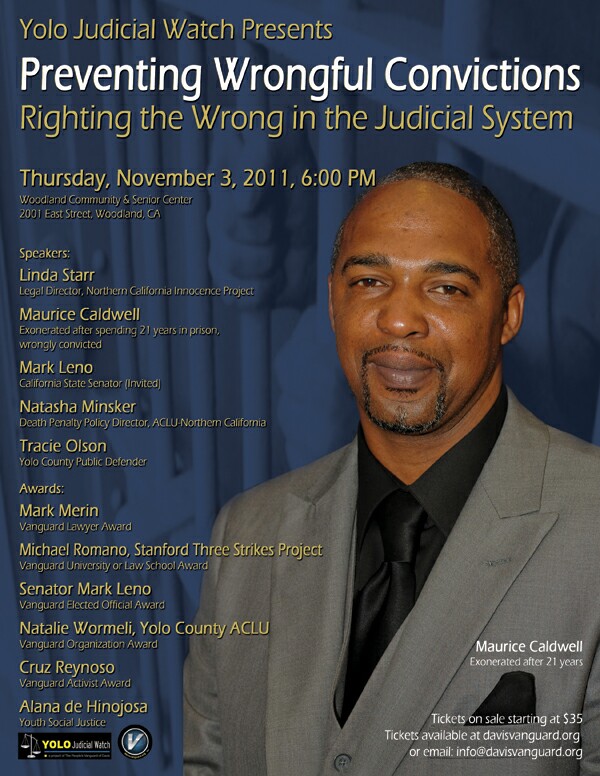
On November 3, Yolo Judicial Watch will focus its attention, at its annual Fundraiser and Awards Ceremony Event, on the issue of preventing wrongful convictions. This event will feature, among others, Linda Starr, the Legal Director of the Northern California Innocence Project, which has played a strong role in a number of recent exonerations.
A judge set aside Mr. Caldwell’s 1991 conviction last December and ordered a new trial, after lawyers for the Northern California Innocence Project (NCIP) at Santa Clara University School of Law demonstrated evidence of actual innocence and that Mr. Caldwell’s defense attorney at trial was incompetent.
A San Francisco Superior Court judge then ordered Mr. Caldwell released when San Francisco prosecutors declined to retry him.
Mr. Caldwell was convicted of a San Francisco murder based on the testimony of a single eyewitness, Mary Cobbs, who originally told police that the shooters did not live in the area and that she did not know their names or nicknames. During an initial interview, police brought Mr. Caldwell, who had been the witness’ neighbor, to her door. Ms. Cobbs did not identify him at the time, but two weeks later picked him out of a photo lineup identifying him by his nickname “Twan.”
New evidence NCIP unearthed shows her testimony was wrong and as a result, Mr. Caldwell has been locked up for a crime he did not commit. It also shows that the actual perpetrators were never apprehended and went on to commit more crimes.
The Innocence Project, an organization founded to free individuals who are wrongly convicted of crimes, took on his case three years ago, after Mr. Caldwell had already served 17 years in prison.
They were able to locate two witnesses who actually saw the murder and testified that Mr. Caldwell had no involvement. They also located a statement from another individual who acknowledged he was the real killer. That man is now serving a life sentence in a Nevada prison for a subsequent murder.
“It is tragic that it has taken 20 years to finally win his release,” said NCIP Legal Director Linda Starr, who represented Mr. Caldwell with NCIP attorney Paige Kaneb. “In the meantime, the actual perpetrators have committed more crimes, including another homicide. Had law enforcement followed up on information they had at the time of this shooting, they could have not only apprehended the actual killers but also prevented the subsequent homicide.”
The case is yet another example of how eyewitness identification can go wrong and lead to the conviction of the innocent. Eyewitness misidentification is the single largest source of wrongful conviction in the United States, Starr explained. “Eyewitness misidentifications play a role in more than 75 percent of convictions overturned through DNA testing,” she said. “Unfortunately, it played a role in Maurice Caldwell’s case as well.”
For his part, Mr. Caldwell is just happy to have his freedom back.
“All the things I dreamed about when I was young, I can now bring to life,” said Mr. Caldwell. “I can’t find a way to say what this means to me and what NCIP means to me. I’m just sorry my mother isn’t here to see this day finally come.”
Earlier in March, the Innocence Project, through the work of Linda Starr, won the release of Francisco Carrillo, 37, who had spent 20 years behind bars, also wrongly convicted of a murder.
He was released after several witnesses recanted their identification of him as the killer in a drive-by shooting. A Los Angeles County Superior Court judge found “that the recantations and other evidence undermined his conviction for the 1991 killing.”
According to published reports, he made this decision “after listening to more than a week of testimony from the witnesses and watching a dramatic reconstruction of the crime scene that raised questions about what the witnesses could have seen on the evening of the shooting.”
“Franky is going to have some life and some freedom, but he lost so much,” said Linda Starr. “It took far too long.”
According to them, “The case underscores what legal experts say is the danger of relying heavily on eyewitness testimony. Studies have shown that faulty identifications are the biggest factor in wrongful convictions and that witnesses are particularly unreliable when identifying someone of a different race. The witnesses who identified Carrillo are black, while he is Latino.”
The LA Times reported in March that, while LA County prosecutors expressed doubts about some of the recantations, they believed that the conviction should be overturned.
In a third case, that came down just two weeks ago, Linda Starr and Paige Kaneb, the Supervising Attorney for the Northern California Innocence Project, were able to get an LA County judge to throw out the conviction of Obie Anthony for a 1995 murder.
Judge Kelvin Filer granted the habeas petition on the basis of the cumulative harm of prosecutorial misconduct, specifically the trial prosecutor’s failure to correct the false testimony of its key witness, and the prosecution’s failure to disclose exculpatory evidence to the defense, specifically the fact that the prosecution’s key witness received a “sweetheart deal” in exchange for his testimony against Mr. Anthony.
In overturning the conviction, Judge Filer said that the prosecution’s chief witness, around whom the entire case for trial was built, “will say almost anything to avoid consequences to himself . . . in an earlier proceeding, he lied about the death of his own mother.”
During the hearing, NCIP and Loyola lawyers demonstrated that the prosecution’s key witness, John Jones, had lied repeatedly at trial, and that the prosecution knew of his lies and failed to correct them for the jury
They also presented evidence that the prosecution suppressed evidence that impeached its witnesses, that Anthony is actually innocent, and that Anthony’s defense attorney at trial failed to investigate and present information that suggested Jones was the actual killer and Anthony was innocent.
Mr. Jones testified at the hearing that, to make his identifications of Anthony, he had relied on descriptions from others, along with suggestions from the detectives and false information they had given him.
Judge Kevin Filer ordered the 37-year-old Obie Anthony released after 17 years, when he became convinced “that the prosecution’s key witness, a pimp, lied to the jury. The witness has since admitted he never clearly saw the gunman at the scene of the crime.”
Judge Filer would “harshly criticize” the prosecutors for their failure to disclose to the jury that they had cut a deal with the witness, “agreeing to seek a light sentence on pimping and pandering charges in exchange for his testimony against Anthony and a co-defendant, Reggie Cole.”
Mr. Cole had won release a few months ago, after a different judge overturned his murder conviction on similar grounds.
He reportedly said after the ruling, “I’m overwhelmed, man, it’s been a long time coming.”
According to an Op-ed by the Innocence Project’s Maurice Possley and Cookie Ridolfi, the judge also found “Los Angeles County Deputy District Attorney George Costello failed to correct the perjured testimony of the key prosecution witness — testimony that he knew was untrue yet allowed to stand to get the conviction. Filer also ruled that Costello had failed to disclose evidence that suggested Anthony was innocent and that Anthony’s defense attorney had failed to fully investigate the case.”
“This conviction should have never happened,” said NCIP Legal Director Linda Starr. “Police purposely ignored and hid evidence that did not support their theory, and manipulated the witnesses to create evidence to support their misguided tunnel vision. The prosecution falsely denied that they granted their star witness a deal for his cooperation and failed to correct his lies at trial. And Mr. Anthony’s own attorney failed to investigate the case. For their failures, Mr. Anthony has spent 17 years in prison for a murder that he did not commit – and the actual murderer has remained free. This cannot be considered justice.”
“Obie Anthony is an innocent man who has survived this ordeal with grace and courage,” said NCIP attorney Paige Kaneb. “Even now, Mr. Anthony is not angry. Instead, he just wants to start his life as a free man, go to college, and then devote his time to helping others.”
According to the Innocence Project, Mr. Anthony was originally convicted of attempted robbery and the murder of Felipe Gonzales near a house of prostitution on March 27, 1994.
The conviction was primarily based, according to the accounts of the Innocence Project, on the testimony of one witness, John Jones, who operated the house of prostitution, had a prior manslaughter conviction, and was known to carry and use firearms.
Police had no leads on the crime until one month later, when Elliot Santana falsely claimed to have been carjacked at gunpoint by three men, and identified Mr. Anthony and two friends, Reggie Cole and Michael Miller, as those men.
Police proceeded to put their photos in photographic lineups and showed them to witnesses in the Gonzales murder. Mr. Jones was the only person to positively identify Mr. Anthony in connection with the Gonzales murder.
At trial, the prosecution’s case rested entirely on eyewitness testimony. The fingerprints lifted from the scene did not match Mr. Anthony, nor did the shoeprints. Detectives found no murder weapon or clothing that matched the descriptions provided by witnesses.
“In fact, no physical evidence ever connected Anthony to the crime,” the Innocence Project contends.
In addition, Mr. Anthony had presented a number of alibi witnesses who testified that he was at home on the night of the murder. Despite this, Mr. Anthony was convicted and received a sentence of life without parole.
The Northern California Innocence Project (NCIP) at Santa Clara University School of Law operates as a pro bono legal clinical program, where law students, clinical fellows, attorneys, pro bono counsel and volunteers work to identify and provide legal representation to wrongfully-convicted prisoners.
To learn about Maurice Caldwell, Linda Starr, and the efforts of the Innocence Project, attend Yolo Judicial Watch’s event on November 3 at the Woodland Community and Senior Center. Tickets are available starting at $35. For additional information about sponsorship opportunities please click here.
—David M. Greenwald reporting





Thank you for sharing cases like these. It gives us hope that the travesty that has happened to Ajay Dev will be overturned. It is just too bad that it took so long to rectify the wrongful convictions. These men lost so much of their lives suffering for a crime they did not commit.